RMB30 Billion Project Launched in Baoshan 42 Years Ago
In October 1977, Ye Zhiqiang, former Vice Minister of the Ministry of Metallurgy, and others went to Zhong Nan Hai to report to the Politburo of the CPC Central Committee what he had seen and felt during his visit to Japan. He spoke of two embarrassing things as follows:
The Japanese treated them, and a waiter bought the cans of beer and drinks that we haven't seen and used. "No one knows how the Japanese can roll steel as thin as a piece of paper and print colorful patterns on it", he said.
The Chinese car failed to keep up with the Japanese car. Later, the Chinese driver had to take the risk to accelerate. As a result, the car broke down, and finally the Chinese people had to sit in the Japanese car. "The car used by the embassy is our best car. The panel is made of hot-rolled steel plate, which is thick, heavy and rusty. The Japanese car is made of cold-rolled steel plate, which is light and beautiful."
Then, Ye Zhiqiang took out his survey report, which showed that Japan's steel industry was 15 to 20 years ahead of China. Everyone was shocked.

In October 1978, Deng Xiaoping went to Japan and visited Kimitsu Iron and Steel Plant of Nippon Steel Corp. He was shocked by the modernization of Japanese iron and steel industry and the economic development gap between China and Japan. At that time, he said, "Just like this, build a steel plant for China." He asked his Japanese friends to introduce their advanced production management experience to the Chinese workers who are practicing here or in the future.
Deng Xiaoping's visit has accelerated the progress of the Baosteel plan.
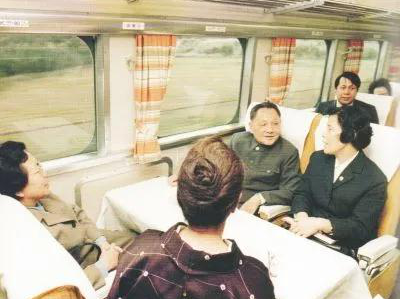
In October 1978, Deng xiaoping took the Shinkansen train when he visited Japan.
Two months after Deng Xiaoping's visit to Japan, on December 23, 1978, the next day after the closing of the 3rd Plenary Session of the 11th CPC Central Committee of the Communist Party of China, Baosteel, which attracted great attention, laid the first steel pile in Shanghai. The Shanghai Baoshan Iron and Steel Complex, with an annual output of 6 million tons of steel and 6 million tons of iron, became the largest project since the founding of new China.
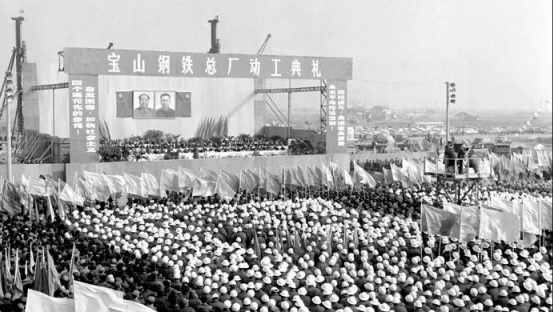
Why was Baoshan chosen?
According to the traditional thinking of China's iron and steel industry, Shanghai is absolutely not suitable for building iron and steel plants without mines and coal.
Li Ming, the first chairman of Baosteel Group, said that when deciding to usher in Japanese technology to build the large-scale iron and steel enterprise at the beginning, the Central Government considered more than a dozen places, including Lianyungang, Tianjin and Dalian. However, Shanghai was the largest industrial city in China, and only its industrial base and comprehensive capacity were enough to support such a modern iron and steel base at that time. In addition, Baosteel learned from the experience of Japan in its design, and the raw materials were imported iron ore with low price and good quality. Shanghai had unique conditions.
Experts put forward that China's super-large iron and steel enterprise should be built in Jinshanwei, and should be named Jinshan Iron and Steel to echo with Jinshan Petrochemical Company. Moreover, the Jinshanwei waterway was deep and the beach was idle. So, less farmland could be expropriated.
After an urgent investigation, the experts finally negated their plan. The reason was that Jinshanwei was close to Hangzhou Bay and was located at the wind outlet of subtropical monsoon landing. The sea waved fiercely, and the tide and velocity fluctuated greatly. It was not easy for ore ships to dock at the wharf when berthing. Because it was far away from Shanghai steel works, it was difficult to solve the problem of hot metal transportation.
There was also a comparison between the east and west schemes in the Yangtze Estuary. The west scheme was based on the area of Shengqiao and Luojing to the west of Shidongkou. The east scheme was to the east of Shidongkou, which was close to county. In the middle of the planning area, there was a gliding school that could be directly used as a construction base. There was also a 3,150-mu abandoned airport built during the Japanese invasion into China, so less land would be expropriated and 1,145 households would not be relocated.
The Japanese expert group and Shanghai officials Su Zhenhua, Ni Zhifu, Peng Chong, Lin Hujia, Chen Jinhua and others immediately visited the scene and finally chose the east scheme. Chen Jinhua said that Shanghai has Jinshan in the south and Baoshan in the north, echoing each other from afar. In this way, Baosteel got its name from Baoshan.

In the early stage of Baosteel's construction, the Baosteel engineering headquarters was located in Dingjiaqiao, Baoshan. Source: China Baowu group
On March 9, 1978, the State Planning Commission, the State Economy Commission, the State Construction Commission, Shanghai Municipality and the Ministry of metallurgy jointly submitted to the State Council the request for instructions on the site selection, construction scale and related issues of the newly built Shanghai Iron and steel plant, proposing that the site of Shanghai Baoshan Iron and Steel Plant could be selected in Yuepu Town, Baoshan, which was approved by the State Council on March 10.
Is it worth overdrawing China?
However, soon after Baosteel started construction, many people opposed it.
What really put the Baosteel project in trouble was investment, and it was too expensive for China at that time!
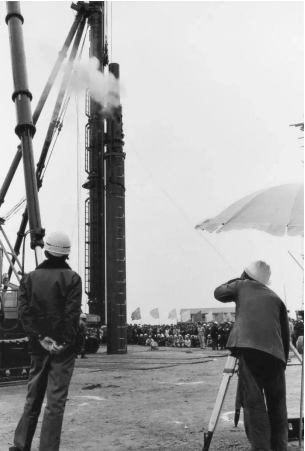
On December 23, 1978, the first steel pipe pile was driven down at the blast furnace site of Baosteel. Source: China Baowu Group
Shortly after the commencement of Baosteel, People's Daily published an article entitled "Let’s calculate for the Construction of Baosteel" written by an official of the Ministry of Finance at that time, thus openly discussing the construction of Baosteel.
Baosteel's accounting information surprised the whole country. To build Baosteel according to the plan, 30 billion yuan was needed. At that time, the national fiscal revenue was only 80 billion yuan, and the National Bank Personal Savings was only 18 billion yuan. At that time, with a population of 1 billion, Baosteel's investment cost 30 yuan per person, which was almost the monthly income of a young worker.
Building Baosteel will overdraw China. All kinds of doubts and criticisms went to Baosteel's huge investment.
In 1979, the national economic situation was not optimistic. After the "Cultural Revolution", the task of national construction was very urgent, and infrastructure projects were blooming everywhere. The central economic work conference held in April this year exposed the problems of overheating and imbalance of the economy. The Central Financial and Economic Commission was established, with Chen Yun as the head of the leadership group. Before the central economic work conference, Chen Yun and Li Xiannian jointly raised the issue of serious imbalance in the proportion of the national economy.
The central government decided to readjust all the projects under construction in China, and Baosteel, the No. 1 project, naturally ranked the first. However, to many people's surprise, Chen Yun, who strongly advised to reduce a large number of infrastructure projects, became a supporter of Baosteel after a week's survey on Baosteel.
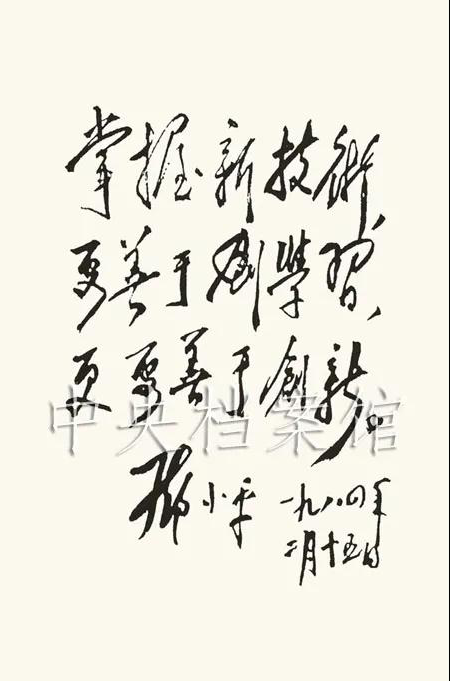
Deng Xiaoping wrote an inscription for Baosteel: To master new technology, we should be good at learning and be better at innovation."
A month later, when Deng Xiaoping met with the new leadership group of Shanghai, he expressed the same attitude: "The municipal Party committee should take charge of Baosteel. The first is to do it, and the second is to make sure it is done well. There are a lot of discussions about Baosteel. We don't regret it. The key issue is to do a good job in building Baosteel".
All kinds of debates at Baosteel became increasingly fierce, and they were sent to Deng Xiaoping. In the face of disputes, Deng Xiaoping asserted at a central meeting in September that year: "The history will prove that it is right to build Baosteel".
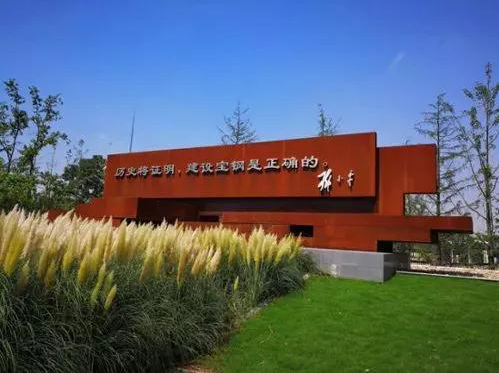
After that, Baosteel faced many difficulties, and finally put into operation on November 26, 1985. The completion of the first phase project of Baosteel marked a big step for the modernization of China's iron and steel industry.
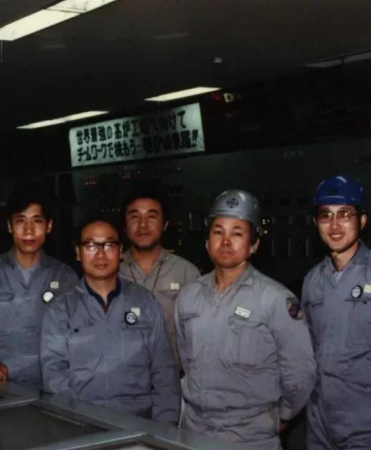
In the summer of 1984, Nippon Steel Corporation of Japan welcomed a group of Chinese interns, the technicians sent by Baosteel to study at Nippon Steel.

On September 15, 1985, the ignition ceremony of Baosteel No. 1 Blast Furnace was held. Source: China Baowu group

A bird's-eye view of Baosteel Phase I project after completion. Source: China Baowu Group
In 1978, China's steel output was only 31.78 million tons, accounting for 4.42% of the world's steel output in that year. In 1996, China's steel output exceeded 100 million tons for the first time, ranking first in the world. Since 2006, China has changed from a net steel importing country to a net steel exporting country, with the self-sufficiency rate of most steel products exceeding 100%, ranking among the world's steel powers.
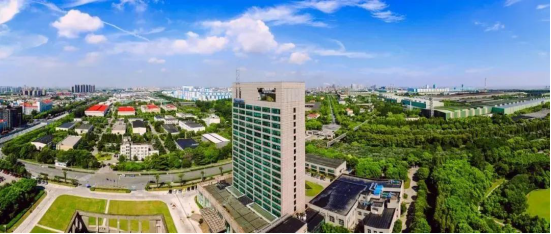
China Baowu Iron and Steel Group Co., Ltd., which was reorganized from the former Baosteel Group and the former Wuhan Iron and Steel Group, was established in December 2016. The picture shows a corner of Baosteel Co., Ltd
Among them, Baosteel played a crucial role. It ended the history that China's steel industry could only provide automotive interior materials, and began to supply to the world's major automobile factories. It broke the monopoly of foreign enterprises on refrigerator panels and steel cables of high-span cable-stayed bridges, made the Chinese use their own steel cans, and made China's 1 yuan coin use domestic steel. It also confirmed Deng Xiaoping's decision with facts: the history will prove that the construction of Baosteel is correct.

In February 1984, Deng Xiaoping inspected Baosteel in Shanghai
Today's Baosteel has completed the merger of Wuhan Iron and Steel Group in February 2017. It has Baoshan (Shanghai), Qingshan (Wuhan), Dongshan (Zhanjiang), Meishan (Nanjing) and other major manufacturing bases. Among the global listed iron and steel enterprises, the output of crude steel of Baosteel ranks the second, the output of automobile plate of Baosteel ranks the third, and the output of oriented electrical steel of Baosteel ranks the first. It is one of the iron and steel enterprises with the most complete varieties of carbon steel in the world.
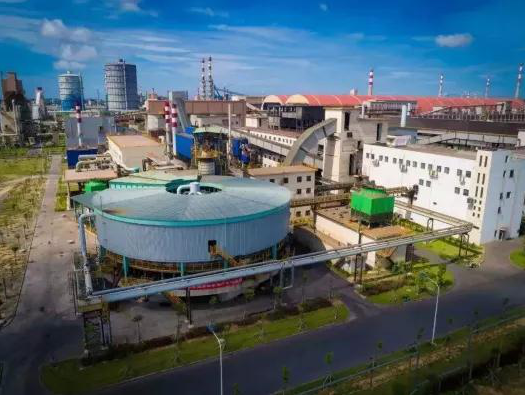

宝山汇APP

上海宝山微信

上海宝山微博